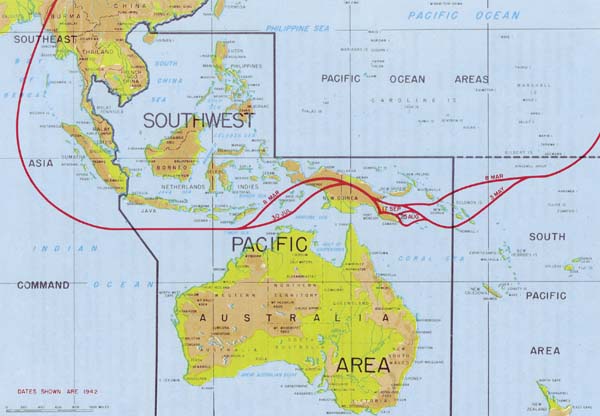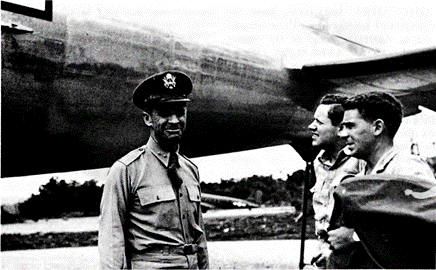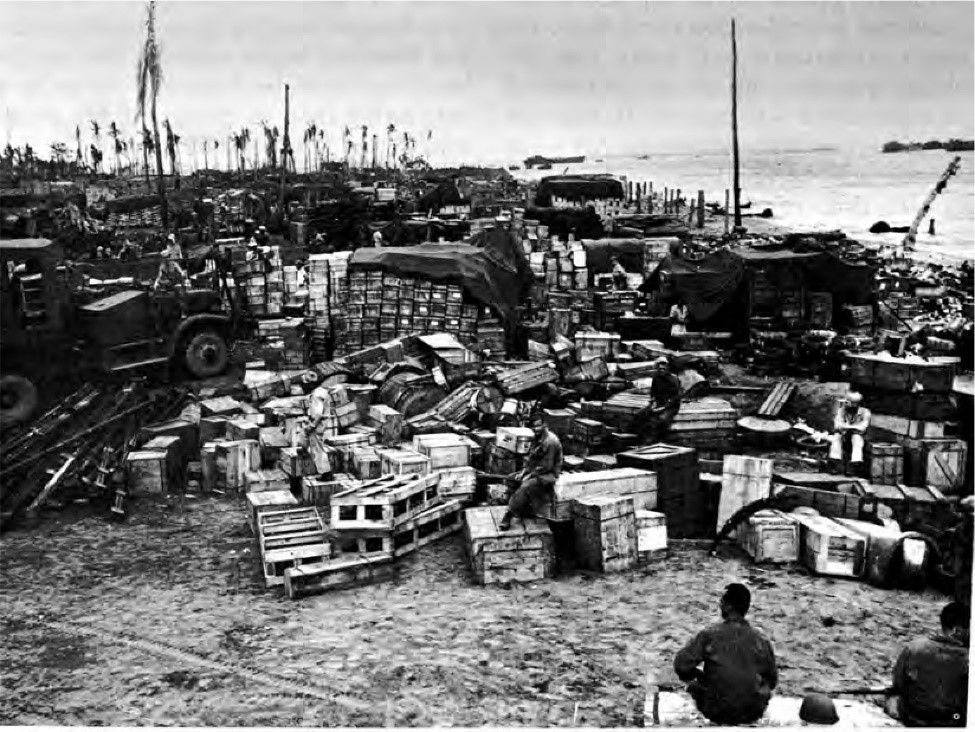Download PDF →
Communications are seldom mentioned in official dispatches or noted in historians’ accounts unless they fail.[1] Comms constitute the weapon placed in the hands of the commander to accomplish the mission, just as the rifle is placed in the hands of an infantryman.[2] The Southwest Pacific Area (SWPA) theater liberation campaign (1943-45) led by GEN Douglas MacArthur demanded innovative communications solutions given the vast distances, jungle terrain, and archipelagic landscape in support of maneuver. Not since that campaign has the United States had such a force presence in the region.

Figure 1. Map of Southwest Pacific Area (1943-1945)
The current DoD and Indo-Pacific strategy calls for a dynamic forward posture and presence in Southeast Asia, South Asia, and Oceania (formerly the SWPA). While the communication challenges and operating environment remain largely unchanged, advanced 21st-century communication technologies will only be as effective as the sophisticated adversarial threat capabilities built to deny them. This retrospective intends to provide context for command and control, and communications for future competition and conflict (if required) in the South Pacific to maintain a free and open Indo-Pacific.
Drawing directly from Center of Military History Publication 10-18 (Signal Corps: The Outcome, mid-1943 through 1945, 1966), the following historical narrative and excerpts capture the SWPA campaign command and control and communications environment.
(From Signal Corps ref) Tropical combat in the Southwest Pacific placed Army communications and the Signal Corps in an environment similar to that of adjacent Pacific Ocean areas. Jungle conditions, excessive heat, and rain sorely strained Signal Corps men and their equipment. Great distances over water required sole dependence upon heavy-duty long-range radio. Actions under Allied and amphibious commands demanded close coordination of signalmen, signal procedures, and signal equipment in co-operation with the Navy, the Marine Corps, and often with British and Dominion forces. These circumstances of military operation were common to the South and Central Pacific as well as to SWPA, but in its organizational structure and manner of operation, SWPA differed. If the Pacific war was principally the Navy's war, Army conforming therewith, SWPA provided an exception. The SWPA staff was primarily Army, not Navy. The naval commander of the Seventh Fleet that supported SWPA, in Morison's words, was seldom admitted to General MacArthur's strategic staff discussions; he was simply told that the General intended to land at such a place on such a date, and the Navy must see that their movement to the objective was properly covered.
Whatever unified command there was in SWPA existed at the top only, in the commander in chief himself, General MacArthur, and in his staff relations. There was in SWPA no joint organization that reached down into the task forces and island commands, as it did in the South and Central Pacific. There were no joint communications centers in SWPA, and no joint units such as Joint Assault Signal Company (or JASCO which later became USMC ANGLICO), until the assaults upon the Philippines. Each participating service maintained its own communication centers and kept its circuits separate for its own sole use. Coordination was accomplished, below MacArthur's GHQ, by co-operation and consent.[3] General HQs SWPA had taken form in MacArthur's hands during the spring of 1942 in Australia. Head of the Signal Section and the Chief Signal Officer, SWPA, was Brig. Gen. Spencer B. Akin. Akin had departed from Corregidor in March 1942 and accompanied MacArthur to Australia.

Figure 2. Major General Akin arrives at Hollandia
He remained the chief signal officer for SWPA throughout the war and beyond, through all the subsequent moves and redesignations of MacArthur's command, from Australia to Tokyo and until his appointment in 1947 as the Chief Signal Officer of the Army in Washington, D.C.
General Akin sought in every way to ensure the success of any operation, moving equipment and personnel as the immediate needs of the situation might require. Whenever he took direct action, he did so in conformity with the wishes of the local commander while informing the GHQ chief of staff. In SWPA operations, the GHQ chief signal officer first arranged for and supervised the necessary signal coordination and cooperation of the several participating forces to the end that confusion, waste, and duplication might be minimized. General Akin gave the highest Army commander in combat areas the responsibility (while providing to him the needed equipment and troops) for the installation and maintenance of major communications facilities. The highest Army commander in most SWPA operations (apart from the conquest of the Lae-Salamaua area by the end of 1943 in which a large number of Australian forces bore the brunt of combat) was General Krueger, commander of the Sixth Army (sometimes called the ALAMO Force). Krueger's signal officer throughout the Pacific war was Col. Harry Reichelderfer.[4]
Colonel Reichelderfer later said in summarizing these and other SWPA signal experiences that each element-Navy, Sixth Army, AAF, SOS-had certain missions, and each, he emphasized, used its own communications. The only joint circuits that they employed were limited to naval gunfire support and to air support communications during the landing phase of an operation. The SWPA command system "worked very well," Reichelderfer told an Armed Forces Staff College audience in 1947, "and I liked the way we did it."[5]
Amphibious assaults, requiring the closest possible contact between air, sea, and ground forces, depended heavily upon radio, the only means of communicating under the circumstances, beyond the reach of ear or eye. The radio blueprints for each action were necessarily complex and extensive. The communications plans for the amphibious portion of an operation, Reichelderfer recalled, "always culminated in a conference prior to the issuance of the necessary field or operation orders which was attended by representatives of GHQ, SOS, Sixth Army, the Navy, and the Air Force." Individual conferences for each of the many actions in the New Guinea area took one or two days. Later on, preceding the large-scale Leyte and Luzon landings, the conferees took much more time. Every detail fell under scrutiny. Frequencies were assigned. Communications procedures and plans for coordination were formulated. The decisions at which the conferees arrived went into the signal annexes of the operation instructions and into the field orders of the troop units.[6]
Conditions under which Signal Corps men worked in SWPA were frequently wretched-wretched for the men, whether laying and maintaining wire or working in message centers, and wretched for the equipment also. The steaming heat often rendered life equally difficult indoors and out. "Imagine," Colonel Reichelderfer commented, "what the in side of a six-ton van, housing nine radio operators ... felt like, completely closed up [under blackout conditions] with the temperature and humidity both in the nineties." Even at that, the communicators perhaps had it a bit better facilities of the Sixth Army, General Krueger himself noted that "priority was given to the message center." He thus underscored the vital importance of the communications links in the isolated circumstances of jungle warfare in the Pacific. He listed as next in priority cooking and eating arrangements, and, last, the shacks and tents for his own headquarters personnel.[7]
The region and its peculiarities directly affected communications. The assignment of radio frequencies that had succeeded farther south failed badly in the scene of these actions. Colonel Reichelderfer found that "frequencies which worked perfectly over the comparable distances at 10 degrees south latitude both day and night, would not function at all at night and were erratic in the daytime in the vicinity of 6 degrees south latitude. A great deal more experience and data on radio propagation," he reported to the Washington headquarters, "will be necessary before the solution will be fully satisfactory." Even Safehand Airplane Courier Service suffered from the climate. Intended to operate on a daily schedule, it could not. Often the couriers and their message pouches had to sit out hours and even days of violent weather. "As this is being written," Reichelderfer commented, "no airplane has arrived or taken off from the airstrip serving this headquarters for three days, because of torrential rainstorms."[8]
Despite transmission troubles, radio was succeeding in carrying Army messages. Ten days after the last of the three landings, Colonel Reichelderfer reported, "the Army is operating a total of 24 high-powered radio circuits. Twelve of these circuits are at the rear echelon and seven are at the Command Post." Small radios worked well, within the recognized limitations imposed by the jungle (the dense vegetation absorbing radio waves, reducing the range of the sets).[9]
"The SCR-300 radio sets," he reported further, "have proved to be a godsend in amphibious operations for ship-shore communications and shore party communications."
Before the end of 1942, as operations against the enemy began in the island and ocean areas northward from Australia, amphibious communications became necessary, and General Akin outfitted a Signal Corps fleet, a flotilla of small vessels equipped with radio. At first, they served in a small way as relay ships from forward areas to headquarters in the rear. Their function soon expanded, however, till they took aboard the forward command post communications facilities. The little aggregation became the Army's CP fleet.[10]
The small communications ships proved so useful in amphibious actions that Army elements in SWPA operations continually competed to obtain their services. Army commanders preferred them to Navy communications ships, or AGC's. For one thing, Navy AGC's were hard to obtain for Army operations. For another, Navy AGC's tended to stay too far offshore, and they tended to depart from the vicinity of land combat as soon as possible. The naval commander of a large AGC was always mindful of enemy suicide boats and planes and he would generally, come darkness, move his ship out several miles from the beach, too far to provide the close communications support that Army elements ashore very much needed.[11] None could deny that these ships served the Army well. Their temporary use to ensure communications so vital to overall success, during the crucial hours and difficult first days of an amphibious action, entirely justified all the effort that went into them.
General Akin himself had no doubt of the value and necessity of Army communication ships in SWPA combat. On 21 March 1944, he set up in GHQ SWPA Signal Section a separate Seaborne Communications Branch to plan for extensive communications afloat and to provide a more adequate CP fleet.
Signal supply in the SWPA, as anywhere else, needed good planning and adequate training of the personnel. There was no time for either. Nowhere else did the signal depots serving overseas experience so many moves and vicissitudes as in SWPA over the thousands of miles of sea and jungle terrain that stretch from Australia to Tokyo. Bad as were these unavoidable difficulties, there were exasperating moves of depot locations made within a single area. There were sharp differences between the views and objectives of signal supply officers at a base and the signal officers at the front. The former, reported Colonel Strasburger, signal officer of the XIV Corps at Bougainville (SOPAC) in mid-1943, sought for his base large quantities of supplies, the need for which was not so much immediate as anticipatory. The signal officer of a tactical unit, however, wanted only a minimum of general supplies but a maximum of whatever was needed to meet immediate requirements.[12]

Figure 3.Signal supply dump, white beach, Leyte
However much of the equipment may have been stored in the rear base depots, not enough of it got into the hands of the troops forward. Such was the complaint of the 162d Infantry Regiment after its operations in the Sala Maua area of New Guinea late in the summer of 1943. "At no time," the regiment complained, "was a sufficient supply of all signal items on hand." The thing the men wanted was an ideal that could never be realized-"a completely equipped signal dump and repair section . . . in operation as near to the action as deemed feasible." [13]
(Author) The Southwest Pacific Theater liberation Campaign and elements of command, control, and communications described here do not reflect the current state of competition for the Theater Army and Joint Force in the Indo-Pacific. We are not at war, do not have the same force presence forward (yet), nor are the resources fully committed to executing a like campaign of ‘competition’. The terrain, climate, and operating environment are unchanged. The ability to command and control is as critical as ever and communications remain the foundational weapon systems for enabling C2. In the coming years, forces operating and competing in the South Pacific will certainly encounter similar communications challenges as MG Akin and his subordinate Signal Officers faced supporting maneuver, supplying and enabling Commanders across an archipelagic landscape. Unlike GEN MacArthur’s SWPA GHQ task organization in 1943, any future competition/fight will undeniably be an integrated ‘joint and coalition’ fight across all echelons, across all domains, and with supporting joint and all domain communication systems. Exercising, experimenting and rehearsing in these geographic areas at scale will validate existing and developing communications capabilities.
By reflecting on lessons learned in SWPA, Signal/Cyber forces have an opportunity to better prepare and enable Theater Army and Joint Force goals for competition in the Indo-Pacific. Limitations and challenges from weather, vegetation, and terrain, and the vast distances are still significant challenges to communications in the Pacific Theater and we are amiss to think that our technological advances in digital and radio communications will make these limitations trivial. The planning of communications was scrutinized because of the complexity of the operations. Deliberate planning with all our end-user organizations must carry the same importance.
Commanders and small units must have layered communication plans that range from digital to denied (either by terrain and weather, or enemy actions). These communications should include:
- Digital Channels
- Line of Sight (LoS) and LoS relay
- High-Frequency comms (HF)
- And mission-type orders when no communication is possible
Finally, the Signal Corps had to figure out HF radios, antennae theory, and radio wave propagation during combat. These skills and art have been largely lost in the US military and should be reinvigorated so we are not learning it again under duress. HF still remains the only form of electronic communication that does not need a relay system.
Endnotes
[1] Center of Military History Publication 10-18 (Signal Corps: The Outcome, 1943-1945, 1966), page 13.
[13] Ibid, page 269
Disclaimer. The opinions, conclusions, and recommendations expressed or implied within are those of the contributors and do not necessarily reflect the views of the Department of Defense or any other agency of the Federal Government.